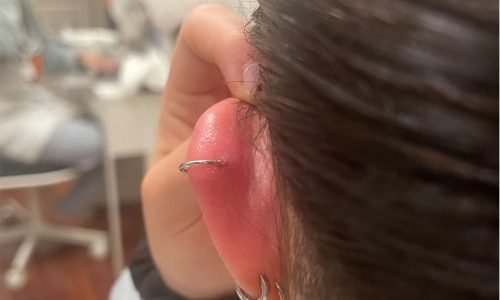Piercing Infection Signs & Treatment
Getting a new piercing is exciting, but without proper care, you risk developing a piercing infection. This guide walks you through how to spot infection early, what usually causes it, how to treat it, and how to prevent future issues.
Piercing Infection: Common Causes You Should Know

Mild redness and tenderness are normal for new piercings. However, if the area becomes unusually warm, swollen, or starts to produce yellow or green discharge, these are red flags for infection. Other signs can include consistent pain, a bad smell, or if the piercing doesn’t improve after a few weeks. In some cases, people also develop a fever, which may indicate that the infection is spreading.
According to Cleveland Clinic, warmth, swelling, and discharge are often the first signs something is wrong.
What Causes Piercing Infections?
Even if you do everything right, piercing infections can still happen especially if a few key precautions are missed. It’s not always about what you do wrong; sometimes it’s what you don’t realize can go wrong. Let’s break down the most common reasons:
Poor Aftercare Practices
The biggest cause of infection is not following proper aftercare. A lot of people assume that cleaning a piercing with alcohol or hydrogen peroxide helps, but that can actually damage skin cells and delay healing. According to RBC Ukraine, saline solution is the safest choice. It gently cleans without causing irritation or drying the skin out. If a piercing infection is left untreated, it can lead to serious complications.
Touching the Piercing or Infected Piercing with Unwashed Hands
We touch so many things every day phones, doorknobs, money. When you touch a new piercing with dirty hands, bacteria gets transferred directly into an open wound. The Centers for Diseases Control and Prevention reminds us that clean hands are non-negotiable when it comes to wound care. It’s a small habit, but it makes a huge difference.
Low-Quality or Non-Sterile Jewelry
Not all jewelry is created equal. Cheap materials like nickel can trigger allergic reactions or slow down the healing process. You want to invest in implant-grade titanium, surgical steel, or solid gold. These are the metals recommended by the Platinum Point because they’re sterile, hypoallergenic, and body-safe.
Swimming in Dirty Water
Pools, lakes, and hot tubs might seem harmless but to a healing piercing, they’re a bacteria bath. If you just got pierced, try to avoid swimming for at least a couple of weeks. Pierced warns that bacteria in unclean water is a leading cause of post-piercing infections. And if you really have to get in the water, cover your piercing with a waterproof bandage to lower the risk.
How to Treat an Infected Piercing
If you suspect your piercing is infected, follow these steps:
1. Clean the Piercing Properly
- Wash your hands before touching the piercing.
- Use a saline solution or a fragrance-free antibacterial soap to clean the area.
- Avoid alcohol or hydrogen peroxide, as these can delay healing (UCLAHealth).
2. Apply a Warm Compress
Using a warm saltwater compress can help reduce swelling, promote blood circulation, and encourage the infection to drain naturally. To do this, dissolve non-iodized sea salt in warm water, soak a clean, lint-free cloth in the solution, and gently press it against the piercing for 5–10 minutes. Repeat this process twice a day for best results.
3. Do Not Remove the Jewelry
Unless instructed by a professional piercer or healthcare provider, avoid removing the jewelry. Taking it out prematurely can cause the wound to close around trapped bacteria, potentially worsening the infection or leading to an abscess. Instead, keep the jewelry in place and focus on proper cleaning and aftercare.
4. Manage Discomfort with Over-the-Counter Pain Relievers
If your piercing feels sore or inflamed, non-prescription pain relievers like ibuprofen or acetaminophen can help reduce swelling and alleviate discomfort. Always follow the recommended dosage and avoid aspirin, as it may increase bleeding in some cases.
5. Know When to See a Doctor
Seek medical attention if:
- The infection worsens despite at-home treatment.
- Red streaks appear around the piercing.
- You develop a fever.
How to Prevent Future Infections
Taking the right precautions can help you avoid infections in the future:
Follow Your Piercer’s Aftercare Instructions – Every piercing has unique healing needs. Trust the aftercare routine recommended by your professional piercer and stick to it consistently.
Use High-Quality, Hypoallergenic Jewelry – Low-quality or non-sterile metals can cause irritation, allergic reactions, and infections. Opt for implant-grade titanium, surgical steel, or solid gold jewelry to promote safe healing.
Avoid Excessive Touching or Rotating – Your piercing is an open wound, and unnecessary movement can introduce bacteria or cause irritation. Only touch it with clean hands when necessary for cleaning.
Keep Hair, Makeup, and Skincare Products Away – Lotions, sprays, and cosmetics can introduce bacteria and clog the piercing, leading to irritation. Be mindful of product application, and keep the area clean and dry.
Conclusion
Recognizing the early signs of a piercing infection and taking prompt action can prevent complications and support a smooth healing process. Proper aftercare is essential to maintaining the health of your piercing, reducing the risk of infection, and ensuring optimal healing. Always follow professional aftercare guidelines, and if you notice persistent pain, excessive swelling, or signs of a severe infection, seek medical attention immediately. Your health and safety should always come first.

